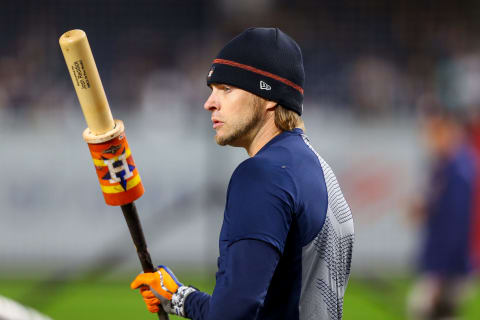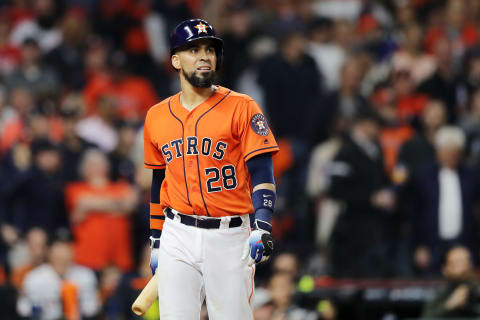Astros: Simulation shows payroll space limited for new additions

With the FanSided MLB Winter Meetings simulation finished, here’s what we learned about the Astros payroll situation.
One of the most fascinating things to watch this offseason with respect to the Astros is how they manage their ballooning payroll. It’s going to be tight even if they stay away from the free agent market entirely. Of course, doing so may not be possible.
They have plenty of holes to fill, most notably behind the plate and on the mound. They are already projected to be over the luxury tax threshold of $208 million, though there is room for some cuts. Still, it’s going to be a difficult balancing act for Jeff Luhnow.
Owner Jim Crane has stated in the past that he has no interest in going over that luxury tax threshold, though his stance seems to have softened some lately. With that in mind, I’m going to pencil in the Astros’ payroll cap at $228 million for 2020.
Why that number? Teams who go over the $208 million mark for the first time have to pay a 20 percent tax on the amount they exceed that mark. If a team exceeds that mark by $20 million to $40 million, they pay an additional 12 percent tax. I would imagine Crane at least wants to avoid that extra surtax.
This is only a temporary solution, of course. If a team’s payroll remains over the luxury tax threshold in consecutive seasons, the tax rate increases each year. So for this to work, the Astros would need to get back under the threshold for 2021.

The Current Situation
The Astros are currently projected to end up with a luxury tax payroll around $223 million, which would put them under that $228 million cap. Keep in mind that when it comes to the luxury tax, it generally uses the average annual value of a player’s deal rather than their salary in that given year.
So for example, while Jose Altuve is set to make $29 million in 2020, his luxury tax figure is only around $23.3 million thanks to him earning less money in the latter years of his contract. Conversely, while Alex Bregman will earn $12.6 million in 2020, his luxury tax figure is $20 million, as he will earn more money in the latter years of his deal.
That $223 million projection includes estimated arbitration salaries of $5.6 million for Aaron Sanchez, $2 million for Chris Devenski and $1.5 million for Joe Biagini. All three could possibly be non-tendered, removing them (and their salaries) from the roster.
It also includes the $13 million Josh Reddick is set to make next year. This is a big reason why he’s a legitimate trade candidate, as the Astros could really use that payroll space for other needs. Kyle Tucker is much cheaper and is the superior offensive player at this point.
But even if they’re able to completely get rid of those four players’ salaries (which is unlikely in Reddick’s case), they’re still sitting at around $201 million, leaving them less than $27 million to work with. It’ll take some frugal shopping to fill all the team’s needs with that amount of money.

The Simulation
Admittedly, this is a bit of a self-critiquing exercise in crunching the numbers. Keep in mind, of course, that none of the moves outlined on this page have actually taken place; these only happened in our FanSided MLB Winter Meetings simulation.
The trade of Reddick for Mark Melancon actually brought in an additional $2.5 million of luxury tax salary, putting us right around $216.8 million. That only leaves around $11 million left, and even in my limited free agent spending, I still went over budget.
The deals for Robinson Chirinos ($5 million) and Rich Hill ($8 million) alone put us over the top. Add on deals for Andrew Cashner ($2 million), Danny Salazar ($1 million), Collin McHugh ($1 million) and Luis Avilan ($1 million) and we’re even further over.
We haven’t even gotten to George Springer‘s extension yet. His luxury tax salary under the contract extension would be slightly less than $2 million more than his projected arbitration salary for 2020, so that’s another small bump and even more added to Crane’s luxury tax bill.
Had I been able to clear all of Reddick’s salary, that would’ve left around $4 million in space under that $228 million cap with all the other additions. But then there would’ve been a hole in the bullpen without having acquired Melancon, and there’s no way to bring Will Harris back at $4 million.
As I wrote, clearing Reddick’s salary wasn’t going to happen. That’s what makes this whole operation so difficult, and it’s going to keep Luhnow busy trying to find ways to build a complete team while keeping the financial implications in mind.

Reality Check
For the fans hoping to see a reunion with Gerrit Cole, this has to come as unwelcome news. It’s hard to pinpoint exactly how much money Cole will command, but in our simulation, he ended up getting $289 million over eight years, which isn’t out of the realm of possibility. The Phillies were the ones who ponied up, but several other teams will be in the mix as well.
What that means is essentially the Astros cannot afford Cole unless they move some serious money off the books, either in the form of Springer or Zack Greinke. Moving Reddick and non-tendering Sanchez and a couple others isn’t going to give them the space to add more than $30 million annually for Cole.
More from Climbing Tal's Hill
- Just how much better is the Houston Astros playoff rotation than the rest?
- Houston Astros: A Lineup Change to Spark Offense
- Astros prospect Hunter Brown throws 6 shutout innings in debut
- Always faithful Astros World Series champion Josh Reddick defends the title
- Michael Conforto declines Astros’ 2-year, $30 million offer
It doesn’t make much sense to move one high-priced player in order to add another. You fill one hole, but you open up another. In all likelihood, the Astros will take the draft pick compensation when Cole signs elsewhere and fill their needs more economically.
Now of course it is possible that the Astros don’t stick to the $228 million cap I’ve set here. But I would be highly surprised if they went beyond that, and I think Luhnow will be making every effort to trim as much payroll space as he can.
As far as 2021 goes, Michael Brantley‘s contract comes off the books, as well as Springer’s and Reddick’s. That should give them enough breathing room to get back under the luxury tax threshold to avoid paying steeper penalties as repeat offenders.
This is a tightrope that Luhnow will have to expertly walk in order to keep the roster stacked while also remaining within whatever financial parameters Crane sets. While we don’t know what cap Crane has given Luhnow, the moves the front office makes will slowly bring that into focus and give us an idea of what the club plans to do for 2020.